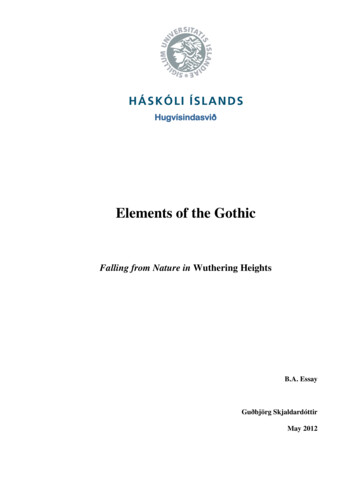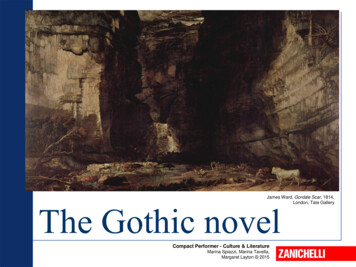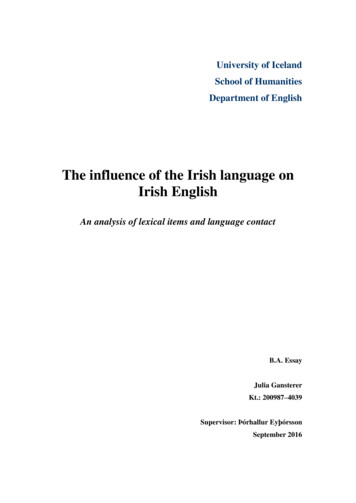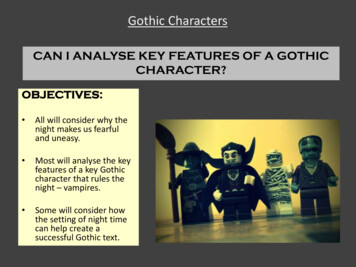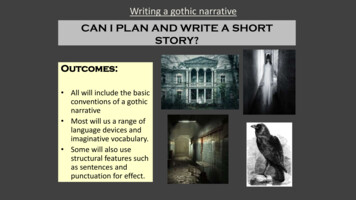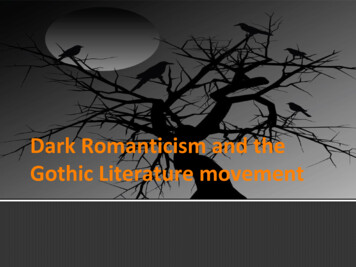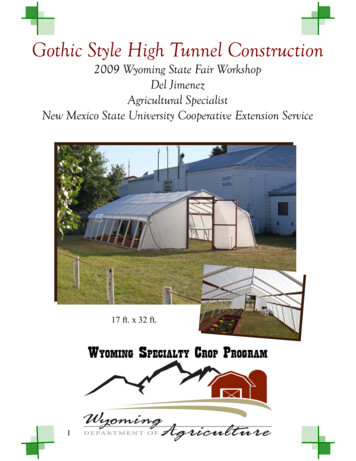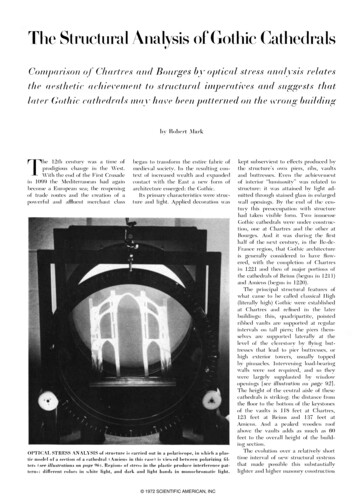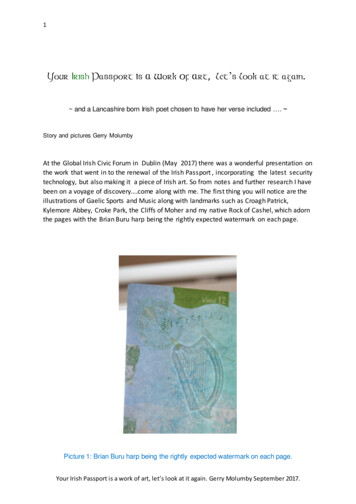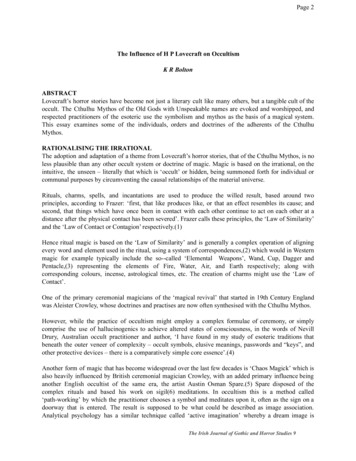
Transcription
Page 2The Influence of H P Lovecraft on OccultismK R BoltonABSTRACTLovecraft’s horror stories have become not just a literary cult like many others, but a tangible cult of theoccult. The Cthulhu Mythos of the Old Gods with Unspeakable names are evoked and worshipped, andrespected practitioners of the esoteric use the symbolism and mythos as the basis of a magical system.This essay examines some of the individuals, orders and doctrines of the adherents of the CthulhuMythos.RATIONALISING THE IRRATIONALThe adoption and adaptation of a theme from Lovecraft’s horror stories, that of the Cthulhu Mythos, is noless plausible than any other occult system or doctrine of magic. Magic is based on the irrational, on theintuitive, the unseen – literally that which is ‘occult’ or hidden, being summoned forth for individual orcommunal purposes by circumventing the causal relationships of the material universe.Rituals, charms, spells, and incantations are used to produce the willed result, based around twoprinciples, according to Frazer: ‘first, that like produces like, or that an effect resembles its cause; andsecond, that things which have once been in contact with each other continue to act on each other at adistance after the physical contact has been severed’. Frazer calls these principles, the ‘Law of Similarity’and the ‘Law of Contact or Contagion’ respectively.(1)Hence ritual magic is based on the ‘Law of Similarity’ and is generally a complex operation of aligningevery word and element used in the ritual, using a system of correspondences,(2) which would in Westernmagic for example typically include the so called ‘Elemental Weapons’, Wand, Cup, Dagger andPentacle,(3) representing the elements of Fire, Water, Air, and Earth respectively; along withcorresponding colours, incense, astrological times, etc. The creation of charms might use the ‘Law ofContact’.One of the primary ceremonial magicians of the ‘magical revival’ that started in 19th Century Englandwas Aleister Crowley, whose doctrines and practises are now often synthesised with the Cthulhu Mythos.However, while the practice of occultism might employ a complex formulae of ceremony, or simplycomprise the use of hallucinogenics to achieve altered states of consciousness, in the words of NevillDrury, Australian occult practitioner and author, ‘I have found in my study of esoteric traditions thatbeneath the outer veneer of complexity – occult symbols, elusive meanings, passwords and “keys”, andother protective devices – there is a comparatively simple core essence’.(4)Another form of magic that has become widespread over the last few decades is ‘Chaos Magick’ which isalso heavily influenced by British ceremonial magician Crowley, with an added primary influence beinganother English occultist of the same era, the artist Austin Osman Spare.(5) Spare disposed of thecomplex rituals and based his work on sigil(6) meditations. In occultism this is a method called‘path working’ by which the practitioner chooses a symbol and meditates upon it, often as the sign on adoorway that is entered. The result is supposed to be what could be described as image association.Analytical psychology has a similar technique called ‘active imagination’ whereby a dream image isThe Irish Journal of Gothic and Horror Studies 9
Page 3chosen for the purpose. Jung describing this method wrote, ‘start with any image, for instance, just withthat yellow mass in your dream. Contemplate it and carefully observe how the picture begins to unfold orto change. Don’t try to make it into something, just do nothing but observe what its spontaneous changesare .’(7)Both shaman and ceremonial occult practitioner, and one might add the LSD experimenters of the Learygeneration, seek altered states of consciousness through acts of will. Additionally there is theinterpretation of dreams which has a lineage far older than modern psychiatric analysis, the dream worldbeing as important to the ancients as the waking world, just as it is recognised today by psychology. Onemight recall the particularly famous examples of dream interpretations or ‘visions’ by Daniel,(8) or that ofJohn described in The Revelation, both examples being replete with esoteric symbolism.The purpose of this brief diversion into basic occult theory is to explain that since any symbol could beused that has sufficient impact on the imagination, or the unconscious of the meditator it can be readilyseen how the Cthulhu Mythos has sufficient influence upon the psyche to be of use as a complete occultsystem, despite its origins in 20th century short stories. The words, imagery and symbols portrayed byLovecraft are sufficiently arcane to excite the imagination, no less than a medieval grimoire, or theEnochian ‘Calls’, alphabet and language devised by Dr John Dee, Queen Elizabeth I’s Court scholar,around which has arisen a major occult school of Enochian magic since the occult revival of the late 19thCentury.(9)Against this fantastical background, we understand how occultists such as Frater Tenebrous, an adherentof the Cthulhu Mythos, explains that Lovecraft was, unwittingly, one of those fantasy writers who couldconvey genuine occult knowledge via dream.(10)On that basis the Esoteric Order of Dagon, one of the primary organisations based on Cthulhu, has offereda particularly cogent explanation as to the legitimacy of Lovecraft’s mythos and indeed of Lovecrafthimself as a seer, despite his own repudiation of the metaphysical:Lovecraft’s fiction, first published in the American pulp magazines such as Weird Tales, presents aninternally consistent cosmology, constructed through the literary realizations of the author’s dreams andintuitive impulses. This cosmology came to be known as the ‘Cthulhu Mythos’, after its central deity.These stories and novels contain hidden meanings and magickal formulae unknown even to their creator.Lovecraft suffered from an acute inferiority complex, which prevented him from personally crossing theAbyss in his lifetime. He remained a withdrawn and lonely writer who retained a rational, skeptical viewof the universe, despite the glimpses of places and entities beyond the world of mundane reality, which hisdream experiences allowed him. He never learned the true origin of the tremendous vistas of cosmicstrangeness that haunted his dreams. He never realized that he was himself the High Priest ‘Ech Pi El’,the Prophet of the dawning Aeon of Cthulhu.(11)Frater Tenebrous similarly explains the relevance of Lovecraft’s stories for the serious occultist:In the 1920’s, an American magazine of fantasy and horror fiction called Weird Tales began to publishstories by a then unknown author named H. P. Lovecraft. As his contributions to the magazine grew moreregular, the stories began to form an internally consistent and self referential mythology, created from theliterary realisation of the author’s dreams and intuitive impulses. Although he outwardly espoused awholly rational and sceptical view of the universe, his dream world experiences allowed him glimpses ofThe Irish Journal of Gothic and Horror Studies 9
Page 4places and entities beyond the world of mundane reality, and behind his stilted and often excessive prosethere lies a vision and an understanding of occult forces which is directly relevant to the MagicalTradition.(12)While the shaman and the occultist will their altered states of consciousness, Lovecraft, a rationalist andmaterialist, is considered by his occult followers as what we might term an ‘unwitting shaman,’ whoseability to channel the denizens of the astral or unconscious realms through dreams is as legitimate as awilled channelling by the occult practitioner.As for Lovecraft’s own world view, he eschewed anything of a mystical nature, and saw the universe asmechanistic. However, Lovecraft nonetheless had an interest not only in science but also in ancienthistory and mythology. Lovecraft scholar S T Joshi writes that Lovecraft, ‘ confessed, acutely, that hisvery love of the past fostered the principal strain in his aesthetic of the weird the defeat or confoundingof time’.(13)His fantasy is therefore a synthesis of the arcane/ mythic and the cosmological: the description ofcreatures lurking beyond the physical universe, waiting for entry through the nightmares of mortals.Hence, the ‘Gods with Unspeakable Names’ are an odd mixture of devil and ‘extraterrestrial’. But unlikeJ R R Tolkien and C S Lewis who wrote their stories in the hope of prompting an interest in the mythicand the religious in the face secularism and materialism, Lovecraft as an atheist had no such desire to seea religious revival. In deprecating attempts to relate quantum theory, for example, to religious beliefs,Lovecraft stated: Although these new turns of science don't mean a thing in relation to the myth of cosmic consciousnessand teleology, a new brood of despairing and horrified moderns is seizing on the doubt of all positiveknowledge which they imply; and is deducing therefrom that, since nothing is true, therefore anything canbe true.whence one may invent or revive any sort of mythology that fancy or nostalgia or desperationmay dictate, and defy anyone to prove that it isn't emotionally true whatever that means (14)As a materialist with a mechanistic view of the universe Lovecraft regarded the supernatural as nonsense,but provided himself with sufficient, albeit scant, knowledge to enable him to include allusions to genuineesoteric figures and texts to provide his tales with arcane plausibility. According to Owen Davies,Lovecraft’s main source of occult information was the entry on ‘Magic’ in the EncyclopaediaBritannica.(15) For example when the Necronomicon was mentioned for a second time, on this occasionin ‘The Festival’, published in 1925 in Weird Tales’, the theme of the story was inspired by Lovecraft’shaving read Margaret Murray’s The Witch Cult in Western Europe,(16 & 17) which was itself aninfluential source for the rebirth of witchcraft or ‘wicca’ or at least the version synthesised into modernexistence by Gerald B Gardner.(18) In ‘The Festival’, a descendant of New England witches finds threegrimoires or occult texts, Saducismus Triumphatus,(19) Daemonolatreia,(20) and the Necronomicon, thefirst two being genuine grimoires.(21)Several genuine characters of occult tradition are alluded to by Lovecraft in his stories, again giving thema tantalising hint of genuine esoteric tradition, including the Elizabethan scholar and inventor of the‘Enochian language’ and method of scrying, Dr John Dee.(22) Hence, when Lovecraft mentions in ‘TheDunwich Horror’ that John Dee provided the only English translation of the Necronomicon, this is takenup as a subject for commentary by Robert Turner, in which he describes his discovery in the BritishMuseum of a letter by an ‘unknown scholar (dated 1573)’ written to Dee, concerning the ‘Towne ofdonwiche’.(23)The Irish Journal of Gothic and Horror Studies 9
Page 5While Lovecraft’s knowledge of the arcane was limited, the vague hints in his tales are themselves thestuff of which esoteric lore and the occult Orders that form around it, are made. The allusions to Dee andgrimoires, etc. provide those looking for a genuine occult tradition in Lovecraft’s tales with grounds forcontending that Lovecraft was a channel for the transmission of an occult tradition that is traced fromSumeria through to the Lovecraftian ‘Mad Arab’, to John Dee, Aleister Crowley, Kenneth Grant, et al.Ironically, Lovecraft’s occult interpreters are committed to precisely what their unwitting shaman foundcontemptible in his own day in those who “invent or revive any sort of mythology and defy anyone toprove that it isn't emotionally true ” Nonetheless Lovecraft provided his stories with sufficientplausibility for seekers of arcane knowledge to enable them to weave a tapestry out of the threads heprovided.‘THE CALL OF CTHULHU’The Cthulhu Mythos manifested first with Lovecraft in his short story ‘The Call of Cthulhu’, published in1928.(24) The ‘heroes’ of the story, at least to the followers of the cult, are the Great Old Ones whoseearthly followers might evoke them from extraterrestrial dimensions when astral alignments are right.Their followers were, from Lovecraft’s description, the most degraded dregs of the Earth:They worshipped, so they said, the Great Old Ones who lived ages before there were any men, and whocame to the young world out of the sky. Those Old Ones were gone now, inside the earth and under thesea; but their dead bodies had told their secrets in dreams to the first men, who formed a cult which hadnever died.(25)Frater Tenebrous, rationalising the existence of the Great Old Ones as objective realities, explains:These entities exist in another dimension, or on a different vibrational level, and can only enter thisuniverse though specific ‘window areas’ or psychic gateways a concept fundamental to many occulttraditions. Cthulhu is the High Priest of the Old Ones, entombed in the sunken city of R’lyeh,(26) wherehe awaits the time of their return. He is described as a winged, tentacled anthropoid of immense size,formed from a semi viscous substance which recombines after his apparent destruction at the conclusionof the tale.(27)The Cthulhu Cult is given a certain objective legitimacy by supposedly having extant remnants since timeimmemorial, examples alluded to by Lovecraft including South Seas Islanders, Voodoo worshippers, andthe angakoks(28) of Greenland.(29) Hence, the present day Western adepts, dedicated to a return of theGreat Old Ones to Earth to assume their godly mantles, claim to be part of a living tradition that has longexisted, the very phenomena Lovecraft deplored in his own time.(30)While it is difficult to discern the doctrines of this cult from Lovecraft’s stories, there is nonethelesssufficient indication to enable a weaving of a dogma that is clearly nihilistic or chaotic as is the nature ofthe Great Old Ones; the new earthly dispensation upon their return evoking a society that many peoplemight consider to be a utopia of psychopathology. Hence Frater Tenebrous cites a passage from theseminal ‘Call of Cthulhu’:(31)The time would be easy to know, for then mankind would have become as the Great Old Ones; free andwild beyond good and evil, with laws and morals thrown aside and all men shouting and killing andThe Irish Journal of Gothic and Horror Studies 9
Page 6reveling in joy. Then the liberated Old Ones would teach them new ways to shout and kill and revel andenjoy themselves, and all the earth would flame with a holocaust of ecstasy and freedom.(32)Frater Tenebrous attempts to bring this pathological, nihilistic outlook into accord with the doctrines ofcertain occult schools, including Templars, Assassins, Gnostics, and in particular the ‘Law of Thelema’the new religion of Lovecraft’s contemporary, Aleister Crowley.(33) This is a theme that is especiallyadopted by Kenneth Grant and those of similar outlook who synthesise Cthulhu with Thelema. While theAeon of Horus as a martial age would be ushered in by conflict, to compare the vision of a Thelemicsociety that Crowley advocates with the a global atavistic bedlam under the regime of the Great Old Onesis to offer a superficial analysis at best, despite all these adepts of Cthulhu seeming to also be well versedin Thelema.Aleister Crowley (1875 1947) has had a seminal influence on the occult revival since the late 19thCentury. His enduring legacy has been helped by the notoriety he sought as the self described ‘GreatBeast 666’, and the sensationalist headlines that appeared in the press in his time describing him as ‘TheKing of Depravity’ and the like. Crowley entered the crypto Rosicrucian(34) society, the Hermetic Orderof the Golden Dawn, the basis of the occult revival in England, whose initiates included W B Yeats, in1898.(35) As befits his temperament Crowley soon argued with the Golden Dawn, and in 1912 transferredhis commitment to a so called ‘sex magical order’, Ordo Templi Orientis, at the invitation of its founder,journalist and German intelligence agent Theodor Reuss.(36) As one would expect from such an energeticpersonality Crowley became Outer Head of the Order, and used the Order as a vehicle for the propagationof his religion for the ‘New Aeon’, Thelema, a synthesis of mysticism and Nietzsche.What Crowley advocated was a society that offered the individual the chance at discovering and fulfillinghis ‘True Will’, or what might be broadly termed in a mundane sense self actualisation. However theThelemic society Crowley advocated was anything but anarchistic let alone nihilistic, being hierarchicallystructured, and reminiscent of the Medieval era but with Thelema replacing Christianity. Crowley wroteof his Thelemic state as conferring both rights and duties, each individual being, ‘absolutely disciplined toserve his own, and the common purpose, without friction’.(37) The Thelemic social structure is based onthe guild, which is also a feature of the organisational structure of Thelemic orders.(38) The premise ofthe Thelemic state Crowley described as being to, ‘gather up all the threads of human passion and interest,and weave them into a harmonious tapestry ’ reflecting the order of the cosmos.(39) This incorporationof all human passions and interests into a ‘harmonious tapestry’ seems remote from the raving, frenetic,murderous lunacy promised by the return of the Great Old Ones and looked upon with enthusiasticexpectation by the Cthulhu cultists.With this moral nihilism the cult of the Great Old Ones must be classified as part of the Left Hand Path,or the sinister tradition, the doctrine of Eastern origin that repudiates orthodox morality. The purestremnant is that of Left Hand Path Tantra as a heresy of Hinduism, where adherents in their rites partake ofthe substances prohibited by orthodox Hinduism, and include women in sexual rituals, regarded as a yogicinterplay of the male and female cosmic principles represented by Shiva and Shakti. In India this is calledVama Marg, Sanskrit for ‘left path’, which according to Kenneth Grant, a Western initiate, who will beconsidered below, is ‘so called because it involves the use of Woman and/or certain organic substancesthat are usually regarded with abhorrence’.(40) Hence the interest by overtly Satanic cults in the West.CULTS OF CTHULHUThe Irish Journal of Gothic and Horror Studies 9
Page 7Kenneth Grant and the Typhonian CultusThe individual most responsible for the development of Cthulhu as an occult system seems to be theBritish occultist Kenneth Grant, one of several claimants to Aleister Crowley’s mantle on the latter’sdeath in 1947.(41) Grant has the advantage of having met Crowley and having been in correspondencewith him as one of his magical students. Grant is also a practitioner of the sigil magic of theaforementioned A O Spare; hence synthesising the two systems, while adding a third element, that ofCthulhu to form ‘Typhonian Thelema’. Grant created the ‘Typhonian’ Ordo Templi Orientis in 1955,(42)as the heir to the occult organisation taken over by Crowley in 1922 from Reuss.(43) Grant’s assumptionto head what was his own version of the OTO with the designation ‘Typhonian’, named after the Egyptiandark god Set(44), emerged in the predictable midst of a conflict of succession following Crowley’s death.Grant has done much in an attempt to reconcile Lovecraft’s nightmare fantasies with ancient mythicentities, the view of Grant and others being that Lovecraft’s ancient (fictional) grimoire, TheNecronomicon, is a legitimate esoteric text extant on the akashic or astral realm and accessed viadreaming. Grant writes of this: ‘As I have shown it is not unlikely that Blavatsky(45), Mathers(46),Crowley(47), Lovecraft and others are reading from an akashic grimoire ’(48)Grant regards Lovecraft and Crowley as parts of the same mythic and occult system, Crowley’s Book ofthe Law (also referred to as Liber Al) being ‘interpreted as the Book of the Law of the Great Old Ones; itis the grimoire containing the keys to mans’ intercourse with Them’.(49) Hence, Lovecraft’s fiction isregarded as a legitimate part of occult tradition, and an important part for Grant and others; as dreaminterpretation has been a major aspect of occultic, shamanic, and religious experiences from antiquity tothe present, in which we might include the prophetic dreams and visions that are a feature of the Old andNew Testaments.(50) Lovecraft attained to visions as a frequent and unwilled part of his dream worldwhile occultists work hard and long to achieve the same results via complicated magical formulas. Thus,Crowley’s ‘Awaiss(51) Current’, Austin Spare’s ‘Zos Kia Cultus’(52), and Lovecraft’s ‘Cthulhu Cultus’,‘are different manifestations of an identical formula – that of dream control’.(53) Grant specificallyalludes to Lovecraft as a ‘magician’:Each of these magicians lived their lives within the context of cosmic dream myths which, somehow, theyrelayed or transmitted to man from other dimensions. The formula of dream control is in a sense used byall creative artists, though few succeed in bringing human consciousness into such close proximity withother spheres.(54)The difference is that Lovecraft was a rationalist of middle class background, who found the imagery eviland horrendous. As Grant explains it, Lovecraft held back from ‘Crossing the Abyss’, which preventedhim from seeing his dreams in magical context and from detaching himself from moral judgements ongood and evil Grant writes of this:The quality of evil with which Lovecraft invests the types of his Cthulhu Cult and other mythoses is theresult of a distortion in the subjective lens of his own awareness, and I have shown elsewhere how theseimages emerge when not so deformed, approximating sometimes to the point of actual identity withCrowley’s cult types of Shaitan Aiwass and The Book of the Law (55)Grant takes to task those Lovecraft fans who claim that their favourite author’s stories are uniquelyoriginal, rather than manifesting a long occult tradition; and for Grant Lovecraft’s status is thereby notdiminished but enhanced, when he is recognised as a channel for cosmic forces of epochal or aeonicsignificance.(56)The Irish Journal of Gothic and Horror Studies 9
Page 8Grant regards Lovecraft as having tapped through dreams, albeit in distorted manner, the same ‘Current’as Crowley, of whom Lovecraft apparently had not heard, Grant providing a number of correspondedbetween the Cthulhu Mythos and that of Crowley:Lovecraft: Al Azif The Book of the Arab; Crowley: Al vel Legis, The Book of the Law.Lovecraft: The Great Old Ones; Crowley: The Great Ones of the Night Time.Lovecraft: Yog Sothoth; Crowley: Sut Thoth, Sut Typhon.Lovecraft: Gnoph Hek (The Hairy Thing); Crowley: Coph Nia (a barbarous name in Liber vel Legis).Lovecraft: The Cold Waste (Kadath); Crowley: The Wanderer of the Waste (Hadith).Lovecraft: Nyarlathotep (a god accompanied by ‘idiot flute players’). Crowley: ‘Into my loneliness comesthe sound of flutes’, Liber VII).Lovecraft: The overpowering stench associated with Nyarlathotep; Crowley: ‘The perfume of Panpervading ‘ (Liber VII).Lovecraft: Great Cthulhu dead, but dreaming in R’lyeh. Crowley: The Primal Sleep, ‘In which the GreatOnes of the Night time are immersed’.Lovecraft: Azathoth (‘the blind and idiot chaos at the centre of infinity’). Crowley: Azoth, the alchemicalsolvent; ‘Thoth, Mercury: Chaos is Hadit at the centre of Infinity (Nuit)’.Lovecraft: The Faceless One (The God Nyarlathotep); Crowley: The Headless One.Lovecraft: The five pointed star carven of grey stone; Crowley: Nuit’s Star: the five pointed star with thecircle in the middle. Grant explains: ‘Grey is the colour of Saturn, the Great Mother of which Nuit is aform’. (57)Of these correspondences, however forced they appear to the non adept, Grant states:The table is interesting because it shows how similarly and yet how differently related were certainarchetypal patterns characteristic of the New Aeon. But whereas to Crowley the motifs conveyed nomoral message, to Lovecraft they were instinct with horror and evil.(58)It could be contended that Grant places too much focus on Lovecraft’s failure to attain adeptship or occultunderstanding of what he was unconsciously channelling because of his alleged moral hang ups; however,as quoted by Joshi, Lovecraft does not seem to have had any such moral prejudices, but rather likeNietzsche to have considered the universe to operate ‘beyond good and evil’.Michael Bertiaux and the Lovecraftian CovenBertiaux is a Chicago based practitioner of ‘Gnostic Voudoo’, synthesising Thelema and Lovecraft, whohas received a lot of interest from Kenneth Grant. Bertiaux’s main vehicle for esoteric transmission is asMaster of the Cult of La Couleuvre Noire, The Black Snake, and director of the Monastery of the SevenThe Irish Journal of Gothic and Horror Studies 9
Page 9Rays.(59) Grant writes of Bertiaux that he ‘claims to have established contact with the “Deep Ones”, thefearful haunters of Outer Spaces that Lovecraft has brought so close to earth in his terrifying fictions’.(60)The Lovecraftian Coven is a branch of the Cult of La Couleuvre Noire, and is led by ‘a priestess of theBlack Snake Cult’.(61) The basis of the practise is that of sexual magic, or what might be called a versionof Left Hand Path Tantra, ‘structured on the basic law of sexual polarity’, with the female principlerepresented by the sea goat which corresponds astrologically with Capricorn, a ‘sea shakti’, mated withthe male principle as the Goat, or ‘sea beast’, or in Lovecraft Shub Niggurath, the Goat of a ThousandYoung.(62)Grant claims that according to August Derleth, who continued the literary tradition of Lovecraft, parts ofWisconsin (where Derleth establish his publishing house) ‘ contain specific Cthulhu power zones’, themost potent being centred on a deserted lake. This area is frequented by Bertiaux and his followers wherethe ‘Deep Ones’ are evoked, whose point of entry to earth lies in the lake itself. The rites are performedwhen astrologically propitious and the ‘Deep Ones’ are said to ‘assume an almost tangible substance’.The performance is one of ceremonial magic and includes the use of paintings and statues of seamonsters, turtles, amphibia and batrachia, consecrated with the kalas (fluids) of the priestess. A specialchant in Creole French is particularly effectual. (63)Church of SatanWithout getting too far off field with definitions, the reader might generally perceive by now that theCthulhu Mythos comes closest to the Western or Judaeo Christian conceptions of ‘Satanism’ and ‘evil’ inthe normally accepted use of the word, although advanced esotericists such as Crowley and Grant wouldeschew the definition of ‘Satanism’ as too limited for their systems. Nonetheless, the Arabic word Shaitandoes appear in the Thelemic cosmology and in particular in that of Grant.(64) Mankind throughout historyand across ethnicities and cultures has had a conception of ‘good and evil’ as a necessity for livingtogether in some type of workable accord. Taboos and commandments with divine sanction are devised tocreate society per se. Lovecraft saw his nightmares as representing figures as entirely negative or evil andlife negating in so far as he believed that ‘good and evil’ is defined as whatever serves the social fabric.Crowley, Grant, and Satanists advance the proposition that the cosmos is an interplay of polarities, the‘evil’ or negation represented in Judaeo Christianity as Satan, ‘the accuser and adversary’, which to suchoccultists is a necessary part of cosmology, otherwise stasis and eventual stagnation would ensue.(65)During the late 19th Century Satan even appeared to certain political rebels as the heroic, archetypal‘rebel in the cosmos’.(66)With the Cthulhu cultists it is difficult to see mere ‘rebellion’ or ‘heresy’ in a zealous commitment tosupposedly ‘restore’ The Great Old Ones to sovereignty over the Earth. The only indication of what typeof regime these Great Old Ones would impose is that of greater and more horrific ways of killing, and theimagery invoked is probably closer to the scenes from a blood and guts soaked Earth from the recentmovie version of the ‘War of the Worlds’(67) where the outer ‘gods’ (?) proceed to feast uponhumankind, than a 19th century romantic revolutionary image of a Miltonian Lucifer enthroned over afreed humanity, or the hierarchical and ordered society that Crowley himself proposed. Despite theattempts of occultists to put a positive and even liberating slant on the return of the Old Ones to reign overthe Earth, Phil Hine has stated more realistically:The Great Old Ones are served by various human, and non human cults in wild and lonely places, from‘degenerate’ swamp dwellers to the innumerable ‘incestuous’ Whateley’s of the fictional region Dunwich.The Irish Journal of Gothic and Horror Studies 9
Page 10These cults are continually preparing both to bring about the return of the Old Ones, and also to silenceanyone who does stumble across the awful secret of the existence of the Old Ones.The return of the Old Ones involves, as Wilbur Whateley puts it in ‘The Dunwich Horror’,(68) the‘clearing off’ of the Earth. That is, the clearing off of humanity, apart from a few worshippers and slaves.This apocalyptic reference can be asserted as metaphorical, or as referring to an actual physicalcatastrophe Nuclear holocaust perhaps? Perhaps Lovecraft wished to emphasise that the Great Old Oneswould give no more thought to wiping out humanity than we might give to wiping up water on a table.Exactly why the Old Ones wish to return to Earth is never clear, but we might assume that for them, Earthis close to the bars and convenient for bus routes!Lovecraft is careful to point out that most of the Old Ones are, in fact, mindless, or ‘idiot go
Frater Tenebrous similarly explains the relevance of Lovecraft’s stories for the serious occultist: In the 1920’s, an American magazine of fantasy and horror fiction called Weird Tales began to publish stories
